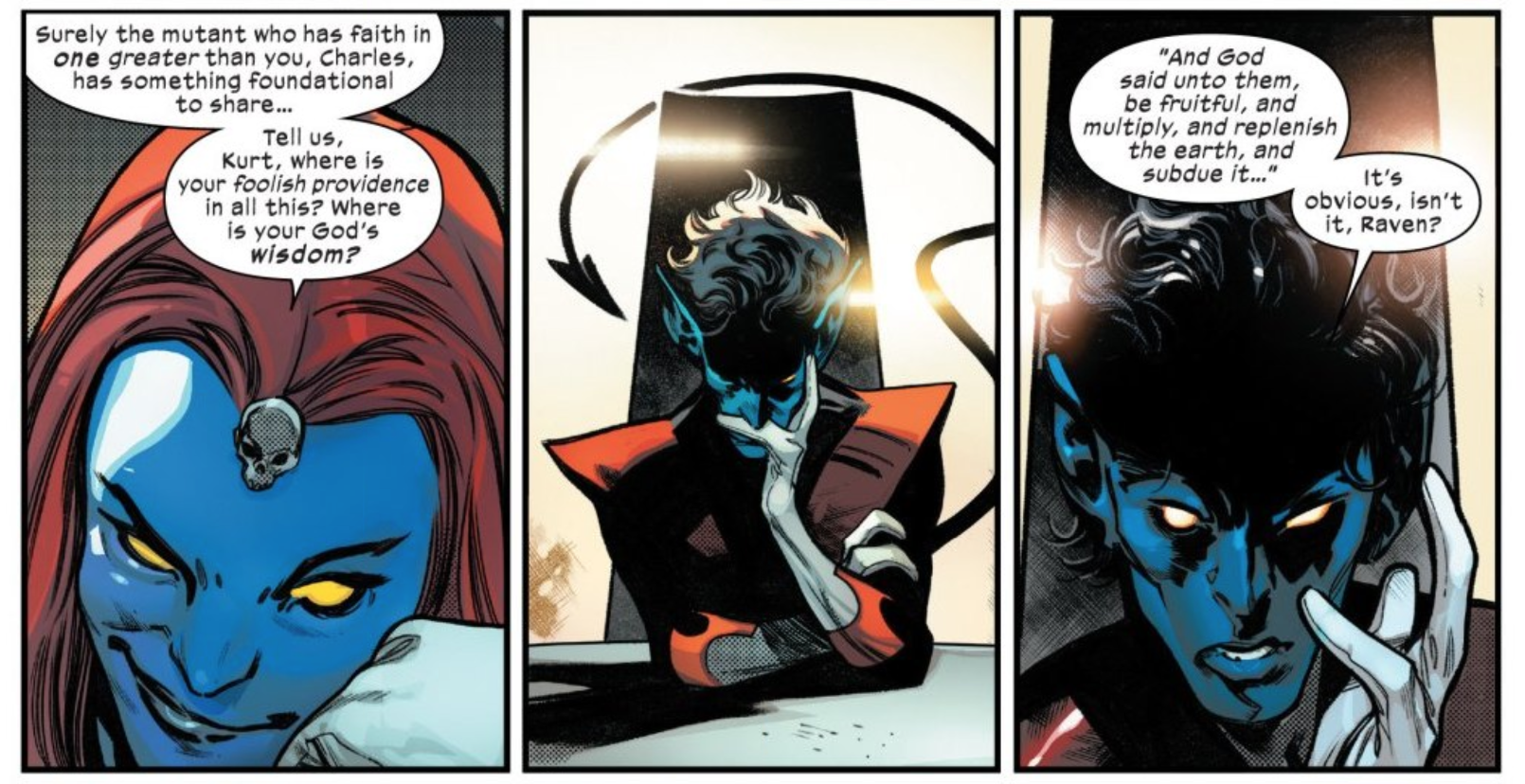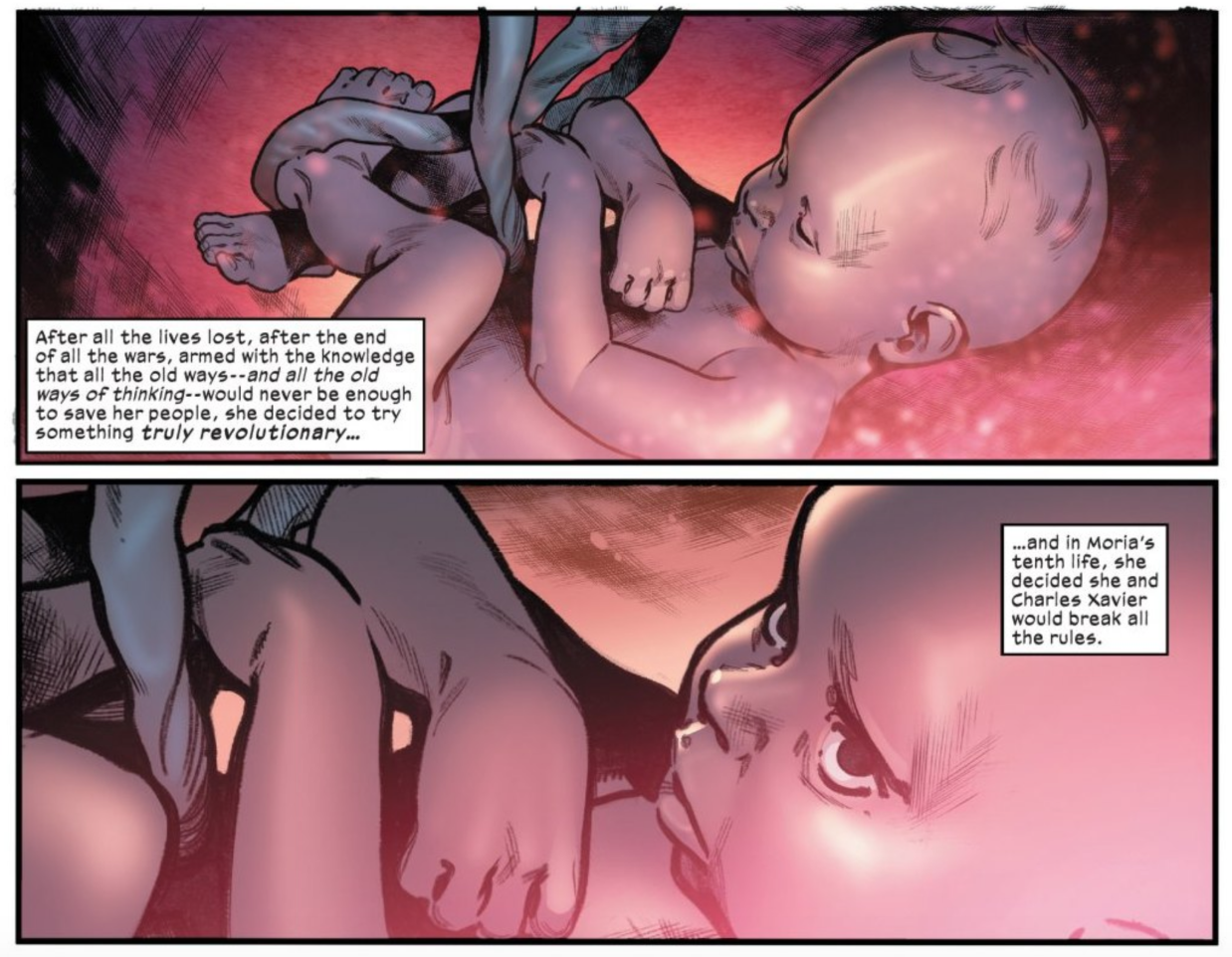I Am Not Ashamed
“I Am Not Ashamed”
House of X #6 (2019)
Written by Jonathan Hickman
Art by Pepe Larraz
Color art by Marte Gracia and David Curiel
The opening sequence of “I Am Not Ashamed” resolves a big question from the first issue of House of X: How did Charles Xavier, who had always preached an assimilationist dream of peaceful coexistence, arrive at the isolationist solution of creating the Krakoa nation-state? The first issue took place in the immediate aftermath of Xavier’s psychic message to the world, and in this issue we get to see that speech in full. Xavier offers his pharmaceutical miracle drugs to humanity in exchange for Krakoan sovereignty, but explains that while he was once inclined to present this as a gift, it will now come at a price and with conditions after being disillusioned by humanity’s genocidal actions against mutants. The change of heart makes sense, and issue #4 laid a lot of the groundwork for this by emphasizing the emotional impact of these genocides on Xavier. Like most everything in House of X/Powers of X, it’s all cause and effect, and it’s a natural evolution of Xavier’s characterization rather than a betrayal of anything that came before.
One of the key narrative shifts in House of X is in reestablishing Charles Xavier as the leader of mutantdom, and as a mostly benevolent and decent man with a big dream. He’s still got some dubious morality and a god complex, but he’s firmly positioned as the protagonist of the story. Much like Chris Claremont, Scott Lobdell, and Grant Morrison before him, Jonathan Hickman presents Xavier as an inspirational visionary rather than as an unethical and manipulative creep, as he was portrayed through much of the past decade and a half. Hickman played on this history a lot through this story, giving the reader reason to be freaked out by Xavier and assume the worst. But at least for now, we can take Xavier to be a good person with honorable goals who is doing what he believes is best for his people, and for the world at large.
The bulk of the issue depicts the first meeting of the Quiet Council of Krakoa, and the establishment of the nation’s first laws as the group decide the fate of Sabretooth. The scene does a good job of asserting the value system of the X-Men – mutants must never kill humans, mutants must multiply and thrive, Krakoa is sacred – and gives Pepe Larraz plenty of room to flex on drawing the body language and facial expressions of the assembled cast. The long shots establish a lot of character detail in physical gesture and bearing, and tighter talking head shots convey volumes about personality in what characters do with their hands as they speak. Even without following the dialogue, you get the gist of the conversation in how they move – Mister Sinister’s flippant cruelty, Storm’s seriousness, the thoughtful quasi-spirituality of Exodus, Emma Frost and Sebastian Shaw’s different shades of blue blood haughtiness, and Mystique’s impatient, dismissive demeanor.
A highlight of the scene is when she interjects to taunt her son Nightcrawler for his religion – their relationship is never mentioned, but her callous disdain for the boy she abandoned is very apparent. Nightcrawler’s thoughtful and kind-hearted reply to her question asked in bad faith is a good argument for nurture mattering more than nature, as he’s clearly a much better man for never being raised by this deeply nihilistic woman.
The final sequence is a celebration of the establishment of Krakoa, and feels a lot like the Ewok celebration conclusion of Return of the Jedi. Larraz also shines here, as he conveys a lot of character beats without the support of dialogue. The scene depicts joyful post-resurrection reunions, a conciliatory moment between Wolverine and his nemesis Gorgon (who has been given a key military leader role), and gives a suggestion of the new dynamic of Cyclops, Jean Grey, and Emma Frost in a cleverly illustrated sequence in which Jean begrudingly passes Emma a beer. It will be fun to see where Hickman goes with this – are we basically going to get an Archie/Betty/Veronica dynamic, or will this get more progressive in its sexual politics? A bit of both would be fun. We’re beyond “human laws” now, but it remains to be seen what gets defined as mutant sexuality, particularly in light of the mandate to procreate.
Some notes:
• We finally get to see Moira X in the present day, though only in a cameo in her No-Space. But what is she up to these days? Why is she in hiding, even from Krakoa? And does anyone besides Charles Xavier and Magneto know about who she actually is and her role as the chief architect of this grand scheme?
• It seems that this panel gives us our first glimpse of Doctor Killian Devo, the director of Orchis. I’m particularly excited about this character, and appreciate that Hickman has made the new main villain of the X-Men a guy called DOCTOR DEVO. Stan and Jack would be very proud!
• I had assumed that we’d get back to Orchis in this issue, but we’ll clearly move on to finding out what their plan is following the destruction of their D̶e̶a̶t̶h̶ ̶S̶t̶a̶r̶ Mother Mold in Hickman’s X-Men series.
• I filled in the map of the primary Krakoa in the Pacific Ocean with the names of locations for my own purposes, but here it is for you too. It’s just a lot easier to take in at a glance this way. Note the friendly tip of the hat to George R.R. Martin!
• We’re nearing the finish line of HOX/POX now, and there’s still a lot to be resolved in the final issue of Powers of X. Like, what will happen when the mutant consciousness archived becomes part of the Phalanx? What happened in Moira’s 6th life, and why has that been a secret? How did Moira find out about the true potential of Krakoa? And do all of those questions actually tie together? The finale of House of X is hopeful and optimistic, but there’s a nagging sense that the finale of Powers of X will show us the hidden cost of all this, or introduce a narrative catch that complicates everything we’ve seen.




























